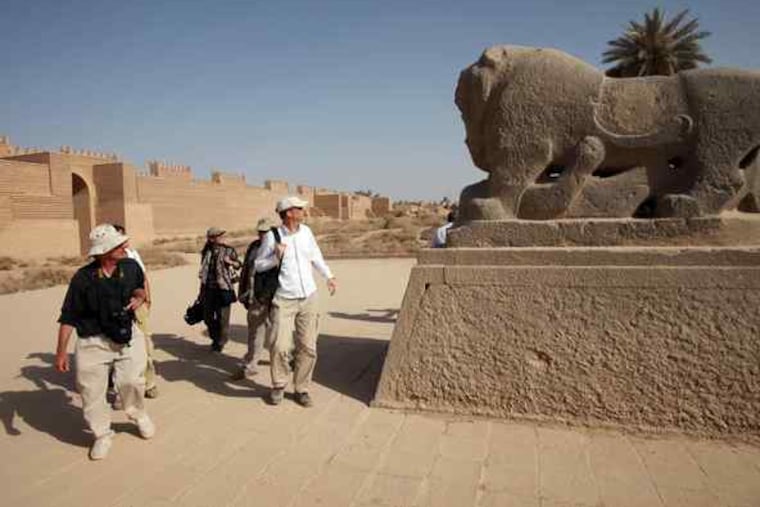War has scarred site of ancient Babylon
A U.N. report blames military activities in Iraq and looting.

BAGHDAD - The U.S.-led invasion of Iraq inflicted serious damage on the site of ancient Babylon, with heavy machinery driven over sacred paths, hilltops bulldozed, and trenches dug through one of the world's greatest archaeological sites, experts for UNESCO said yesterday.
"The use of Babylon as a military base was a grave encroachment on this internationally known archaeological site," said a report that the U.N. cultural agency presented in Paris.
UNESCO officials stressed that the damage did not begin with the U.S. military's arrival nor fully end after it left.
Archaeologists took away some of Babylon's finest treasures in the 19th century, Saddam Hussein embellished the site with his own structures, and looters returned when the Americans handed the site back to the Iraqis 21 months after the March 2003 invasion.
Now Babylon, 60 miles south of Baghdad, is the object of a turf war between newly empowered Iraqi officials. At the national level, Iraq's state antiquities office, focused on conservation, is up against officials of the province surrounding Babylon who want to attract tourists. They have already provoked concern by leveling a section of the site to create a picnic area.
UNESCO aims to make the 4,000-year-old city fit for the coveted title of World Heritage site, "so that what happened to Babylon can't ever happen again," said Francoise Riviere, the agency's undersecretary-general for culture.
Archaeologist John Curtis of the British Museum, who inspected the site just after it was returned to Iraqi control, said it was too soon to assess the cost of restoring and fully protecting the site.
Several initiatives to save Babylon have been announced in recent years but have made little headway. Now hopes are pinned on a two-year, $700,000 project financed by the State Department to develop a program aimed at balancing tourism and archaeology at Babylon.
The Future of Babylon Project is a partnership of the World Monuments Fund, a New York-based nonprofit, and Iraq's State Board of Antiquities and Heritage.
A WMF team of experts toured the site last month and came away surprised at the extent of conservation problems - some of them cases of good intentions gone bad, such as preserving walls with thick plaster.
"On some walls, the plaster was too thick and fell off, pulling down part of the wall with it," Gina Haney, a WMF expert on the tour, said.
Jeffrey Allen, an expert with the WMF team, said the 2003 war bought the restoration project some time because it prevented premature, ill-supervised development of the site. But looters rampaged through Babylon after the invasion.
The U.S. military did not immediately respond to requests for comment, but in the past it has said the looting would have been worse had its troops not been there.
U.S. forces staffed the site until September 2003, when they were replaced by Poles.
The UNESCO report did not single out the nationalities of the forces on the base, except to mention "contractors employed by them, mainly KBR," an American company that was then a Halliburton subsidiary.
The report said KBR contractors "caused major damage to the city by digging, cutting, scraping, and leveling."
KBR spokeswoman Heather Browne said the company would not comment before seeing the report.
The report said steel stakes were driven into ancient walls, which included fragments with inscriptions from the time of King Nebuchadnezzar II, who ruled 21/2 millennia ago and is credited with building the Hanging Gardens of Babylon - one of the Seven Wonders of the ancient world.